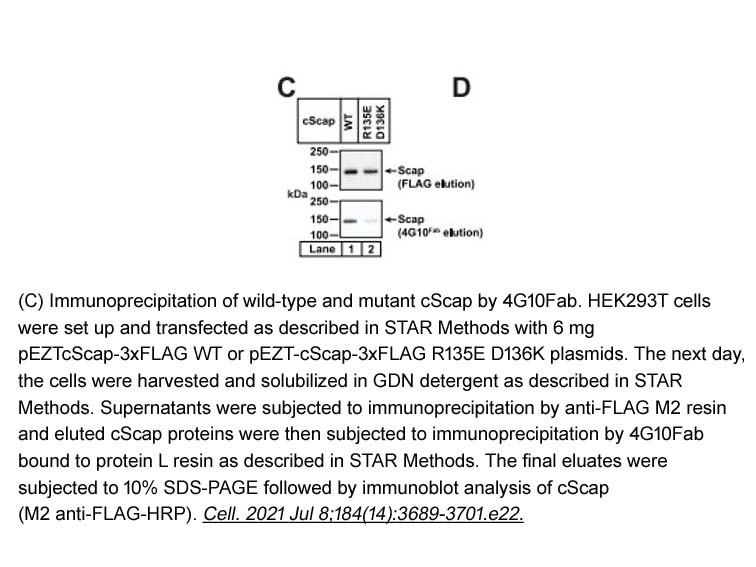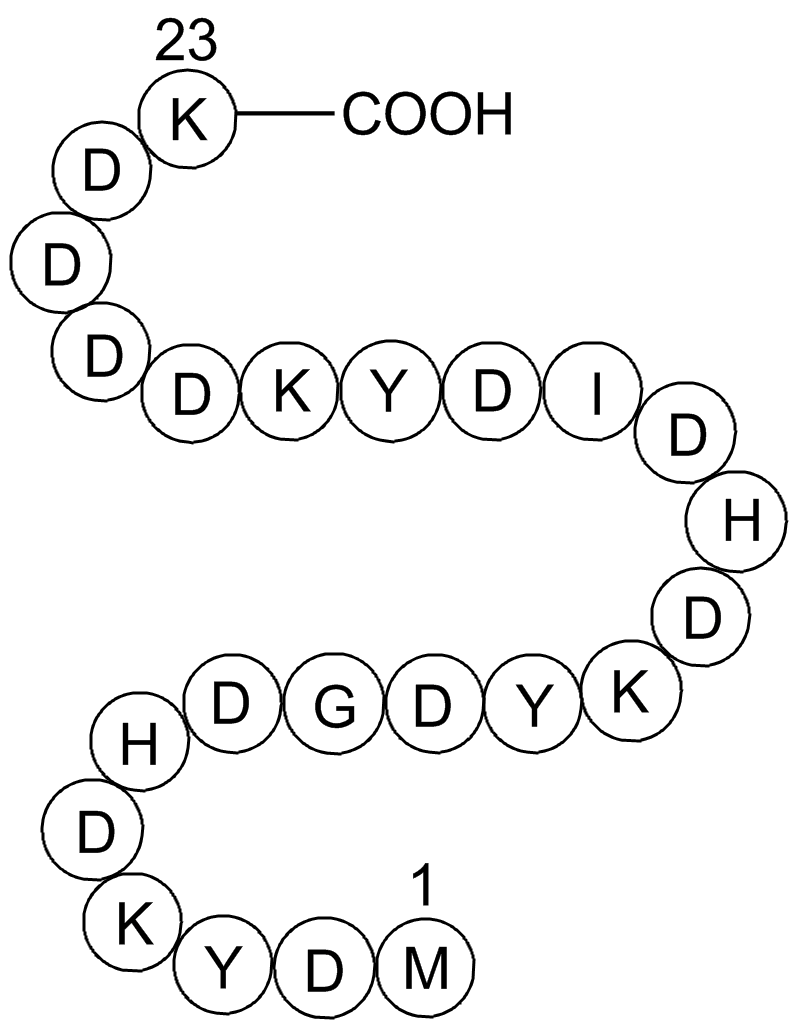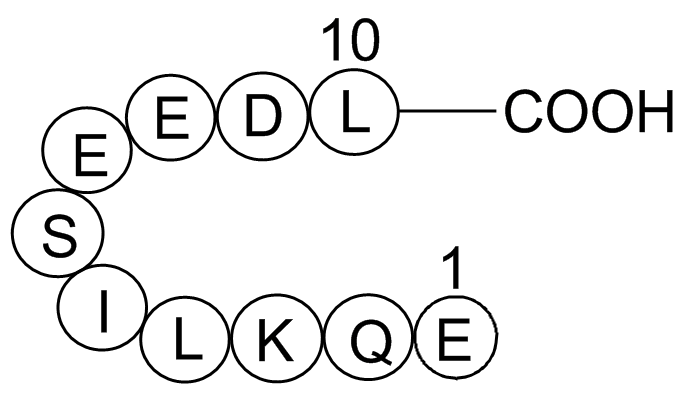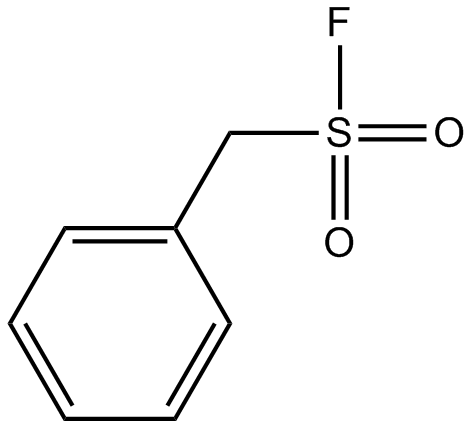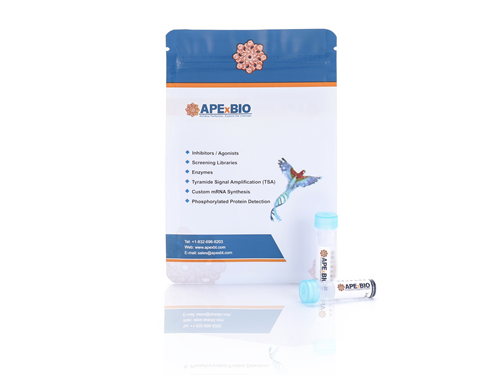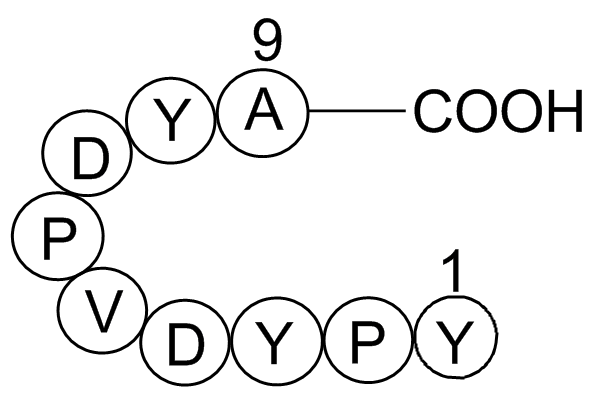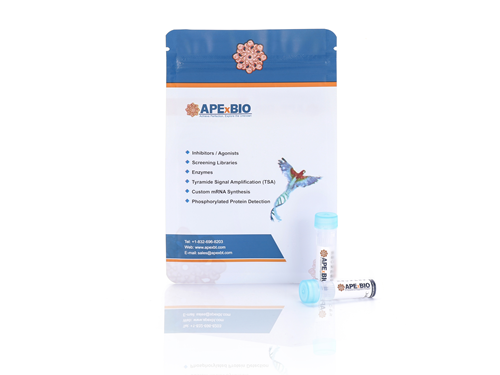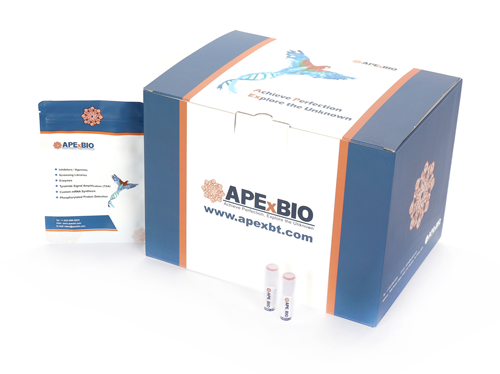3X (DYKDDDDK) Peptide
The 3X FLAG peptide, consisting of three tandem repeats of the sequence DYKDDDDK, is widely utilized in biological research as an epitope tag for recombinant protein detection and purification. Its hydrophilic, 23-residue structure facilitates effective exposure and recognition by monoclonal antibody anti-FLAG M1 or M2(MA5839), improving sensitivity for fusion protein identification. After fusion to target proteins, this peptide tag allows affinity-based isolation or immunodetection methods in various experimental conditions. Due to its small size and hydrophilicity, the 3X FLAG peptide minimally interferes with protein structure and function, including protein crystallization procedures for structural analysis.
References:
1. Hopp TP, Prickett KS, Price VL, Libby RT, March CJ, Ceretti DP, Urdal DL, Conlon PJ (1988) A short polypeptide marker sequence useful for recombinant protein identification and purification. Bio/Technology 6:1204–1210.
2. Hopp TP, Gallis B, Prikett KS (1996) Metal-binding properties of a calcium dependent monoclonal antibody. Mol Immunol 33:601–608.
3. Einhauer A, Jungbauer A (2000) Kinetics and thermodynamical properties of the monoclonal antibody M1 directed against the FLAG peptide. 20th International symposium on the separation of proteins, peptides, and polynucleotides (ISPPP). Lublijana, Slovenia, November 5–8, 2000.
4. Bucher MH, Evdokimov AG, Waugh DS (2002) Differential effects of short affinity tags on the crystallization of Pyrococcus furiosus maltodextrin-binding protein. Biol Cryst 58:392–397.
5. Maroux S, Baratti J, Desnuelle P (1971) Purification and specificity of procine enterokinase. J Biol Chem 246:5031–5039.
- 1. Alfred M. Lentzsch, Ziyi Fan, Inayat U. Irshad. "HYPK promotes N-terminal protein acetylation through rapid ribosome exchange of NatA." Mol Cell. 2025 Dec 18;85(24):4562-4574.e6. PMID: 41380682
- 2. Eli Zecharia, Linor Shalev, et al. "A homolog of methionine γ-lyase is required for biofilm development in the cyanobacterium Synechococcus elongatus." World J Microbiol Biotechnol. 2025 Nov 25;41(12):475. PMID: 41288838
- 3. Melvin Yamsek, Mengxiao Ma, Roshan Jha. "Structural basis of regulated N-glycosylation at the secretory translocon." Nature. 2025 Nov 19. PMID: 41261126
- 4. Arunkumar Sundaram, Qianru Li, Yu Wan. "Global analysis of translocon remodeling during protein synthesis at the ER." Nat Struct Mol Biol. 2025 Oct 20. PMID: 41116047
- 5. René Rasche, Björn Udo Klink, et al. "Structure and mechanism of the RalGAP tumor suppressor complex." Nat Commun. 2025 Jul 30;16(1):7002. PMID: 40738882
- 6. T Winkelmolen, P Colleoni, et al. "VULGARE ROW-TYPE SIX 5 binds to the promoter of tillering and floral homeotic genes to regulate their expression." Plant Physiol. 2025 Jul 17:kiaf309. PMID: 40671593
- 7. Christopher Nardone, Julian Mintseris, et al. "A heterotrimeric protein complex assembles the metazoan V-ATPase upon dissipation of proton gradients." Nat Struct Mol Biol. 2025 Jul 11. PMID: 40646309
- 8. Martin Gamerdinger, Blanca Echeverria, et al. "Mechanism of cotranslational protein N-myristoylation in human cells." Mol Cell. 2025 Jul 17;85(14):2749-2758.e8. PMID: 40639378
- 9. Udana V Ariyaratne, Valentine O Nwanelo, et al. "Proteomics-Based Trapping to Study Substrates of Histone Deacetylase 6 Catalytic Domain 1." Biochemistry. 2025 Jul 1;64(13):2778-2792. PMID: 40543084
- 10. Weilong Chen, Yuanyuan Qin, et al. "FAM50A drives breast cancer brain metastasis through interaction with C9ORF78 to enhance ʟ-asparagine production." Sci Adv. 2025 Jun 18;11(25):eadt3075. PMID: 40531994
- 11. Wataru Obuchi, Ayrton Zargani‐Piccardi, et al. "Engineering of CD63 Enables Selective Extracellular Vesicle Cargo Loading and Enhanced Payload Delivery." J Nanobiotechnology. 2025 Jun 21;23(1):459. PMID: 40527733
- 12. Gregory Fettweis, Kaustubh Wagh, et al. "Transcription factors form a ternary complex with NIPBL/MAU2 to localize cohesin at enhancers." Nucleic Acids Res. 2025 May 10;53(9):gkaf415. PMID: 40377219
- 13. Zhewen Dong, Xiaofei She, et al. "The E3 Ligase NEDD4L Prevents Colorectal Cancer Liver Metastasis via Degradation of PRMT5 to Inhibit the AKT/mTOR Signaling Pathway." Adv Sci (Weinh). 2025 Jul;12(26):e2504704. PMID: 40279519
- 14. Douglas R Wassarman, Patrick Pfaff, et al. "Deazaguanylation is a nucleobase-protein conjugation required for type IV CBASS immunity." bioRxiv [Preprint]. 2025 Apr 6:2025.04.06.647259. PMID: 40236162
- 15. Michael J. McKenna, Felix Kraus, et al. "ARMC1 partitions between distinct complexes and assembles MIRO with MTFR to control mitochondrial distribution." Sci Adv. 2025 Apr 11;11(15):eadu5091. PMID: 40203102
- 16. Jordan Matthew Ngo, Justin Krish Williams, et al. "p62 sorts Lupus La and selected microRNAs into breast cancer-derived exosomes." bioRxiv [Preprint]. 2025 Mar 20:2025.03.20.644464. PMID: 40166149
- 17. Samantha F. Sedor, Sichen Shao et al. "Mechanism of ASF1 engagement by CDAN1." Nat Commun. 2025 Mar 16;16(1):2599. PMID: 40091041
- 18. Christopher Nardone, Jingjing Gao, et al. "Structural basis for the midnolin-proteasome pathway and its role in suppressing myeloma." bioRxiv [Preprint]. 2025 Feb 23:2025.02.22.639686. PMID: 40027645
- 19. Agustin Leonardo Lujan, Ombretta Foresti, et al. "TANGO2 is an acyl-CoA binding protein." J Cell Biol. 2025 May 5;224(5):e202410001. PMID: 40015245
- 20. Hao Chen, Cole J. Ferguson, et al. "The Hao-Fountain syndrome protein USP7 regulates neuronal connectivity in the brain via a novel p53-independent ubiquitin signaling pathway." Cell Rep. 2025 Feb 25;44(2):115231. PMID: 39862434
- 21. Adam T Fishburn , Cole J Florio, et al. "Microcephaly protein ANKLE2 promotes Zika virus replication." mBio. 2025 Feb 5;16(2):e0268324. PMID: 39804047
- 22. Chengyu Shi, Fangzhou Liu, et al. "Comprehensive discovery and functional characterization of the noncanonical proteome." Cell Res. 2025 Jan10. PMID: 39794466
- 23. Liuke Sun, Yuxing Qu, et al. "Functional redundancy in chicken ANP32A mediates species-specific support of avian influenza virus polymerase." bioRxiv [Preprint] March 25, 2025
- 24. Christian Much, Sandy M. Rajkumar, Liming Chen. "Distinct specificity and functions of PRC2 subcomplexes in human stem cells and cardiac differentiation." Volume 85, Issue 16p3057-3073.e10August 21, 2025
- 25. Casey E. Wing, Ho Yee Joyce Fung, Bert Kwanten. "SINE compounds activate exportin 1 degradation through an allosteric mechanism." Nature Chemical Biology volume 21, pages2002–2013 (2025)
- 26. Kai Thoris, Miguel Correa Marrero, et al. "Uncoupling FRUITFULL's functions through modification of a protein motif identified by co-ortholog analysis." Nucleic Acids Res. 2024 Oct 30:gkae963. PMID: 39475190
- 27. Irina S Abaeva, Alexander G Bulakhov, et al. "The ribosome-associated quality control factor TCF25 imposes K48 specificity on Listerin-mediated ubiquitination of nascent chains by binding and specifically orienting the acceptor ubiquitin." bioRxiv. 2024 Oct 18:2024.10.17.618946. PMID: 39464025
- 28. Casey Elizabeth Hudman-Wing, Ho Yee Joyce Fung, et al. "Allosteric degraders induce CRL5ASB8 mediated degradation of XPO1." bioRxiv. 2024 Oct 11:2024.10.07.617049. PMID: 39416201
- 29. Zhe Zhuang, Woong Sub Byun, et al. "Discovery of electrophilic degraders that exploit SNAr chemistry." bioRxiv. 2024 Sep 27:2024.09.25.615094. PMID: 39386645
- 30. Ria S Peesapati, Brianna L Austin-Byler, et al. "A specific folate activates serotonergic neurons to control C. elegans behavior." Nat Commun. 2024 Sep 30;15(1):8471. PMID: 39349491
- 31. Zi-Wei Chen, Satyanarayana M Chintala, et al. "Three classes of propofol binding sites on GABAA receptors." J Biol Chem. 2024 Sep 11:107778. PMID: 39270821
- 32. Amanda DiGuilio, Ben Cheng, et al. "The prolyl isomerase FKBP11 is a secretory translocon accessory factor." Mol Biol Cell. 2024 Nov 1;35(11):ar135. PMID: 39259761
- 33. Alireza Ghanbarpour, Bertina Telusma, et al. "An asymmetric nautilus-like HflK/C assembly controls FtsH proteolysis of membrane proteins." bioRxiv. 2024 Aug 10:2024.08.09.604662. PMID: 39149393
- 34. Samantha F Sedor, Sichen Shao, et al. "Mechanism of ASF1 Inhibition by CDAN1." bioRxiv. 2024 Aug 8:2024.08.08.607204. PMID: 39149339
- 35. Joan Onwunma, Saeed Binsabaan, et al. "The structural and biophysical basis of substrate binding to the hydrophobic groove in Ubiquilin Sti1 domains." bioRxiv. 2024 Jul 10:2024.07.10.602902. PMID: 39026758
- 36. Yan Li, Yuxiang Lin, et al. "MAZ-mediated up-regulation of BCKDK reprograms glucose metabolism and promotes growth by regulating glucose-6-phosphate dehydrogenase stability in triple-negative breast cancer." Cell Death Dis. 2024 Jul 18;15(7):516. PMID: 39025830
- 37. Siddhi Omkar, Courtney Shrader, et al. "Acetylation of the yeast Hsp40 chaperone protein Ydj1 fine-tunes proteostasis and translational fidelity." bioRxiv. 2024 Jun 13:2024.06.13.598777. PMID: 38915721
- 38. Aaron J O Lewis, Frank Zhong, et al. "Structural analysis of the dynamic ribosome-translocon complex." Elife. 2024 Jun 18:13:RP95814. PMID: 38896445
- 39. Merijn Kerstens, Carla Galinha, et al. "PLETHORA transcription factors promote early embryo development through induction of meristematic potential." Development. 2024 Jun 15;151(12):dev202527. PMID: 38884589
- 40. Wu S, Dai X, et al. "Targeting high circDNA2v levels in colorectal cancer induces cellular senescence and elicits an anti-tumor secretome." Cell Rep. 2024 Apr 12;43(4):114111. PMID: 38615319
- 41. David L, Borges JP, et al. "NINJ1 mediates plasma membrane rupture by cutting and releasing membrane disks." Cell. 2024 Apr 2:S0092-8674(24)00300-3. PMID: 38614101
- 42. Rebecca A Oot, Stephan Wilkens, et al. "Human V-ATPase function is positively and negatively regulated by TLDc proteins." Structure. 2024 Mar 28:S0969-2126(24)00091-1. PMID: 38593795
- 43. Yue Guo, Yutaka Kasai, et al. "IGSF3 is a homophilic cell adhesion molecule that drives lung metastasis of melanoma by promoting adhesion to vascular endothelium." Cancer Sci. 2024 Apr 9. PMID: 38590281
- 44. Li M, Zhang C, et al. "Structural insights into human EMC and its interaction with VDAC." Aging (Albany NY). 2024 Mar 15;16(6):5501-5525. PMID: 38517390
- 45. Jee Min Kim , Claudia C Carcamo, et al. "Dynamic 1D Search and Processive Nucleosome Translocations by RSC and ISW2 Chromatin Remodelers." Elife. 2024 Mar 18:12:RP91433. PMID: 38497611
- 46. Bastidas RJ, Kędzior M, et al. "The acetylase activity of Cdu1 regulates bacterial exit from infected cells by protecting Chlamydia effectors from degradation." Elife. 2024 Feb 15;12:RP87386. PMID: 38358795
- 47. Syriste L, Patel DT, et al. "An acetyltransferase effector conserved across Legionella species targets the eukaryotic eIF3 complex to modulate protein translation." mBio. 2024 Mar 13;15(3):e0322123. PMID: 38335095
- 48. Min Hao, Xinyu Ling, et al. "Tracking endogenous proteins based on RNA editing-mediated genetic code expansion." Nat Chem Biol. 2024 Feb 1. PMID: 38302606
- 49. Rea M. Lardelli, et al. "Sm complex assembly and 5′ cap trimethylation promote selective processing of snRNAs by the 3′ exonuclease TOE1." Proc Natl Acad Sci U S A. 2024 Jan 16;121(3):e2315259121. PMID: 38194449
- 50. Neng Wan, Zhouping Hong, et al. "Spartin-mediated lipid transfer facilitates lipid droplet turnover." Proc Natl Acad Sci U S A. 2024 Jan 16;121(3):e2314093121. PMID: 38190532
- 51. Tana R Gazdik, Jacob J Crow, et al. "Notch intracellular domains form transcriptionally active heterodimeric complexes on sequence-paired sites." Sci Rep. 2024 Jan 2;14(1):218. PMID: 38168761
- 52. Olazabal-Herrero A, He B, et al. "The FANCI/FANCD2 complex links DNA damage response to R-loop regulation through SRSF1-mediated mRNA export." Cell Rep. 2024 Jan 23;43(1):113610. PMID: 38165804
- 53. René Rasche, Björn Udo Klink, et al. "Structure and mechanism of the RalGAP tumor suppressor complex." bioRxiv. November 25, 2024
- 54. Xijun Zhu, Woong Sub Byun, et al. "Activating p53Y220C with a Mutant-Specific Small Molecule." bioRxiv. October 28, 2024
- 55. Zhewen Dong, Xiaofei She, et al. "The E3 ligase NEDD4L prevents colorectal cancer liver metastasis via degradation of PRMT5 to inhibit the AKT/mTOR signaling pathway." bioRxiv. October 24, 2024
- 56. T. Winkelmolen, P. Colleoni, et al. "VRS5 (HvTB1) binds to the promoter of tillering and floral homeotic genes to regulate their expression." bioRxiv 23 August 2024 Biology, Environmental Science
- 57. Liuke Sun, Xing Guo, et al. "Human ANP32A/B are SUMOylated and utilized by avian influenza virus NS2 protein to overcome species-specific restriction." bioRxiv 20 July 2024
- 58. Ashley Scheutzow, Sachini Thanthirige, et al. "E3 ligase recruitment by UBQLN2 protects substrates from proteasomal degradation." bioRxiv. July 04, 2024
- 59. Neng Wan, Zhouping Hong, et al. "Spartin-mediated lipid transfer facilitates lipid droplet turnover." bioRxiv. 2023 Nov 29:2023.11.29.569220. PMID: 38076959
- 60. Hao Chen, Cole J Ferguson, et al. "The Hao-Fountain syndrome protein USP7 regulates neuronal connectivity in the brain via a novel p53-independent ubiquitin signaling pathway." bioRxiv. 2023 Oct 27:2023.10.24.563880. PMID: 37961719
- 61. Janani Sridar, Amirhossein Mafi, et al. "Cryo-EM structure of human PAPP-A2 and mechanism of substrate recognition." Commun Chem. 2023 Oct 28;6(1):234. PMID: 37898658
- 62. Jake W Carrasquillo Rodríguez, Onyedikachi Uche, et al. "Differential reliance of CTD-nuclear envelope phosphatase 1 on its regulatory subunit in ER lipid synthesis and storage." bioRxiv. 2023 Oct 13:2023.10.12.562096. PMID: 37873275
- 63. Do-Won Jeong, Jong-Wan Park, et al. "Palmitoylation-driven PHF2 ubiquitination remodels lipid metabolism through the SREBP1c axis in hepatocellular carcinoma." Nat Commun. 2023 Oct 12;14(1):6370. PMID: 37828054
- 64. Blake M Hauser, Maya Sangesland, et al. "Heterologous sarbecovirus receptor binding domains as scaffolds for SARS-CoV-2 receptor binding motif presentation." bioRxiv. 2023 Aug 22;2023.08.21.554179. PMID: 37662405
- 65. Tiantai Ma, Erica S Xiong, et al. "The 3′ exonuclease TOE1 selectively processes snRNAs through recognition of Sm complex assembly and 5′ cap trimethylation." bioRxiv. 2023 Aug 17;2023.08.15.553431. PMID: 37645788
- 66. Tana R Gazdik, Jacob J Crow, et al. "Notch Intracellular Domains form Transcriptionally Active Heterodimeric Complexes on Sequence-paired Sites." Res Sq. 2023 Jul 26;rs.3.rs-3147210. PMID: 37546896
- 67. Sarah Perlee, Sota Kikuchi, et al. "SETD1A function in leukemia is mediated through interaction with mitotic regulators BuGZ/BUB3." EMBO Rep. 2023 Aug 3;e57108. PMID: 37535603
- 68. Kyung W Seo, Ralph E Kleiner, et al. "Profiling dynamic RNA-protein interactions using small molecule-induced RNA editing." Nat Chem Biol. 2023 Nov;19(11):1361-1371. PMID: 37349582
- 69. Irina S Abaeva, Yani Arhab, et al. "In vitro reconstitution of SARS CoV-2 Nsp1-induced mRNA cleavage reveals the key roles of the N-terminal domain of Nsp1 and the RRM domain of eIF3g." bioRxiv. 2023 May 26:2023.05.25.542379. PMID: 37292671
- 70. Hofman DA, Ruiz-Orera J, et al. "Translation of non-canonical open reading frames as a cancer cell survival mechanism in childhood medulloblastoma." bioRxiv. 2023 May 6:2023.05.04.539399. PMID: 37205492
- 71. Conner L Olson, Alexandra T Barbour, et al. "RPA engages telomeric G-quadruplexes more effectively than CST." Nucleic Acids Res. 2023 Jun 9;51(10):5073-5086. PMID: 37140062
- 72. Na Zhang, Qianying Hu, et al. "Unique progerin C-terminal peptide ameliorates Hutchinson–Gilford progeria syndrome phenotype by rescuing BUBR1." Nat Aging. 2023 Feb;3(2):185-201. PMID: 37118121
- 73. Haining Zhou, Wenzhi Feng, et al. "SENP3 and USP7 regulate Polycomb-rixosome interactions and silencing functions." Nat Cell Rep. 2023 Apr 25;42(4):112339. PMID: 37014752
- 74. Shuwen He, John P Gillies, et al. "Distinct dynein complexes defined by DYNLRB1 and DYNLRB2 regulate mitotic and male meiotic spindle bipolarity." Nat Commun. 2023 Mar 27;14(1):1715. PMID: 36973253
- 75. Seo-Hyun Kim, Young-Sin Cho, et al. "Endolysosomal impairment by binding of amyloid beta or MAPT/Tau to V-ATPase and rescue via the HYAL-CD44 axis in Alzheimer disease." Autophagy. 2023 Aug;19(8):2318-2337. PMID: 36843263
- 76. Liu Y, Liu K, et al. "Mitochondrial SENP2 regulates the assembly of SDH complex under metabolic stress." Cell Rep 2023 Jan 27;42(2) PMID: 36708515
- 77. Hiroki Tateiwa, Satyanarayana M Chintala, et al. "The Mechanism of Enantioselective Neurosteroid Actions on GABAA Receptors." Biomolecules. 2023 Feb 9;13(2):341. PMID: 35014105
- 78. Patrick Günther, et al. "Structural investigation of cholesterol homeostasis and bacterial toxins." Technischen Universität Dortmund. 22.08.2023
- 79. Hongwen Chen, Yu Qin, et al. "Transmembrane protein CD69 acts as an S1PR1 agonist." BioRxiv. February 15, 2023
- 80. Yao Gong, Gaurav Behera, et al. "HypDB: A functionally annotated web-based database of the proline hydroxylation proteome." PLoS Biol. 2022 Aug 26;20(8):e3001757. PMID: 36026437
- 81. Daniel Frank, Sarah E Garnish, et al. "Ubiquitylation of RIPK3 beyond-the-RHIM can limit RIPK3 activity and cell death." iScience. 2022 Jun 17;25(7):104632. PMID: 35800780
- 82. Md Mahfuz Al Mamun, Muhammad Riaz Khan, et al. "Stub1 maintains proteostasis of master transcription factors in embryonic stem cells." Cell Rep. 2022 Jun 7;39(10):110919. PMID: 35675767
- 83. Yang Xu, Han Han, et al. "Active conformation of the p97-p47 unfoldase complex." Nat Commun. 2022 May 12;13(1):2640. PMID: 35552390
- 84. Lin Liu, Jarrod J. Sandow, et al. "Tankyrase-mediated ADP-ribosylation is a regulator of TNF-induced death." Sci Adv. 2022 May 13;8(19):eabh2332. PMID: 35544574
- 85. S Grace Herod, Annie Dyatel, et al. "Clearance of an amyloid-like translational repressor is governed by 14-3-3 proteins." Cell Rep. 2022 May 3;39(5):110753. PMID: 35508136
- 86. Michael G Hanna, Patreece H Suen, et al. "SHIP164 is a chorein motif lipid transfer protein that controls endosome–Golgi membrane traffic." J Cell Biol. 2022 Jun 6;221(6):e202111018. PMID: 35499567
- 87. Zhongxia Yi, René M Arvola, et al. "Mammalian UPF3A and UPF3B can activate nonsense‐mediated mRNA decay independently of their exon junction complex binding." EMBO J. 2022 May 16;41(10):e109202. PMID: 35451102
- 88. Haining Zhou, Chad B Stein, et al. "Rixosomal RNA degradation contributes to silencing of Polycomb target genes." Nature. 2022 Apr;604(7904):167-174. PMID: 35355014
- 89. Justin G Meyerowitz, Michael J Robertson, et al. "The oxytocin signaling complex reveals a molecular switch for cation dependence." Nat Struct Mol Biol. 2022 Mar;29(3):274-281. PMID: 35241813
- 90. Akhil Gargey, Yuri E Nesmelov. "The Local Environment of Loop Switch 1 Modulates the Rate of ATP-Induced Dissociation of Human Cardiac Actomyosin." Int J Mol Sci. 2022 Jan 22;23(3):1220. PMID: 35163146
- 91. Yi Zhao, Pierre A. Miranda Herrera, et al. "Function-guided proximity mapping unveils electrophilic-metabolite sensing by proteins not present in their canonical locales." Proc Natl Acad Sci U S A. 2022 Feb 1;119(5):e2120687119. PMID: 35082156
- 92. Mutchler, Ashley S. "The role of Esc2 and DNA in Smc5/6-mediated Sgs1-Top3-Rmi1 sumoylation." Texas State University. 2022
- 93. Connor Quinn. "Molecular Drivers of Disease Pathogenesis in Nonalcoholic Steatohepatitis." Temple University. August 2022
- 94. Jessica J Lenoir, Jean-Patrick Parisien, et al. "Immune regulator LGP2 targets Ubc13/UBE2N to mediate widespread interference with K63 polyubiquitination and NF-κB activation." Cell Rep. 2021 Dec 28;37(13):110175. PMID: 34965427
- 95. Jean-Patrick Parisien, Jessica J Lenoir, et al. "The Human STAT2 Coiled-Coil Domain Contains a Degron for Zika Virus Interferon Evasion." J Virol. 2021 Oct 13;JVI0130121. PMID: 34643427
- 96. Wei Yuan, Qais Al-Hadid, et al. "TDRD3 promotes DHX9 chromatin recruitment and R-loop resolution." Nucleic Acids Res. 2021 Sep 7;49(15):8573-8591 PMID: 34329467
- 97. Xingyu Pan, Jingrong Zhao, et al. "5'-UTR SNP of FGF13 causes translational defect and intellectual disability." Elife. 2021 Jun 29;10:e63021. PMID: 34184986
- 98. Daniel L. Kober, Arun Radhakrishnan, et al. "Scap structures highlight key role for rotation of intertwined luminal loops in cholesterol sensing." Cell. 2021 Jul 8;184(14):3689-3701.e22 PMID: 34139175
- 99. Tingjuan Deng, Boli Hu, et al. "Inhibition of Antiviral Innate Immunity by Avibirnavirus VP3 via Blocking TBK1-TRAF3 Complex Formation and IRF3 Activation." mSystems. 2021 May 11;6(3):e00016-21. PMID: 34055057
- 100. Patricia R Nano, Taylor K Johnson, et al. "Structure-activity mapping of ARHGAP36 reveals regulatory roles for its GAP homology and C-terminal domains." PLoS One. 2021 May 17;16(5):e0251684. PMID: 33999959
- 101. Lingli He, Wentao Yu, et al. "An optimized two-step chromatin immunoprecipitation protocol to quantify the associations of two separate proteins and their common target DNA." STAR Protoc. 2021 Apr 27;2(2):100504. PMID: 33997818
- 102. Yevgeni Yegorov, Eleonora Sendersky, et al. "A Cyanobacterial Component Required for Pilus Biogenesis Affects the Exoproteome." mBio. 2021 Mar 16;12(2):e03674-20. PMID: 33727363
- 103. Ke Zhang, Lisa Miorin, et al. "Nsp1 protein of SARS-CoV-2 disrupts the mRNA export machinery to inhibit host gene expression." Sci Adv. 2021 Feb 5;7(6):eabe7386. PMID: 33547084
- 104. Haijing Guo, Jen-Hsuan Wei, et al. "Importin α phosphorylation promotes TPX2 activation by GM130 to control astral microtubules and spindle orientation." J Cell Sci. 2021 Feb 19;134(4):jcs258356 PMID: 33526712
- 105. Akhil Gargey, Shiril Bhardwaj Iragavarapu, et al. "Electrostatic interactions in the SH1-SH2 helix of human cardiac myosin modulate the time of strong actomyosin binding." J Muscle Res Cell Motil. 2021 Jun;42(2):137-147. PMID: 32929610
- 106. Frank, Daniel, et al. "The role of RIPK3 ubiquitylation and MLKL signalling during cell death and autophagy." University of Melbourne. 2021
- 107. Joshua A Lees, PeiQi Li, et al. "Insights into Lysosomal PI (3, 5) P2 Homeostasis from a Structural-Biochemical Analysis of the PIKfyve Lipid Kinase Complex." Mol Cell. 2020 Nov 19;80(4):736-743.e4. PMID: 33098764
- 108. Corinna Kosnopfel, Tobias Sinnberg, et al. "Tumour Progression Stage-Dependent Secretion of YB-1 Stimulates Melanoma Cell Migration and Invasion." Cancers (Basel) 2020 Aug 18;12(8):2328. PMID: 32824741
- 109. Martin Mehnert, Rodolfo Ciuffa, et al. "Multi-layered proteomic analyses decode compositional and functional effects of cancer mutations on kinase complexes." Nat Commun. 2020 Jul 16;11(1):3563. PMID: 32678104
- 110. Wu Y, Jin S, et al. "Selective autophagy controls the stability of transcription factor IRF3 to balance type I interferon production and immune suppression." Autophagy. 2020;1-14 PMID: 32476569
- 111. Howard SM, Ceppi I, et al. "The internal region of CtIP negatively regulates DNA end resection." Nucleic Acids Res. 2020;48(10):5485-5498 PMID: 32347940
- 112. Xiao J, Li W, et al. "Targeting 7-Dehydrocholesterol Reductase Integrates Cholesterol Metabolism and IRF3 Activation to Eliminate Infection." Immunity. 2020;52(1):109–122.e6 PMID: 31882361
- 113. Mitchell DC, Menon A, et al. "Cyclin-dependent kinase 4 inhibits the translational repressor 4E-BP1 to promote cap-dependent translation during mitosis-G1 transition." FEBS Lett. 2020 Apr;594(8):1307-1318. PMID: 31853978
- 114. Jesse R. Poganik, Alexandra K. Van Hall-Beauvais, et al. "The mRNA-binding protein HuR is a kinetically-privileged electrophile sensor." Helvetica Chimica Acta.10.1002 10.1002/hlca.202000041
- 115. Haijing Guo, Jen-Hsuan Wei, et al. "TPX2 activation by GM130 controls astral microtubule formation and spindle orientation." bioRxiv. March 17, 2020
- 116. Andrii Bugai. "REGULATION OF POL II TRANSCRIPTIONAL RESPONSE TO DNA DAMAGE BY RBM7 AND P-TEFb." University of Helsinki.2020
- 117. Liu J, Feng J, et al. "Arginine methylation-dependent LSD1 stability promotes invasion and metastasis of breast cancer." EMBO Rep. 2019 Dec 12:e48597 PMID: 31833203
- 118. Luo A, Chen Y. "Label-free Interactome Analysis Revealed an Essential Role of CUL3-KEAP1 Complex in Mediating the Ubiquitination and Degradation of PHD2." J Proteome Res. 2019 Nov 25 PMID: 31763849
- 119. Qin X, Tang HT, et al. "An Orthogonal Tyrosyl-tRNA Synthetase/tRNA Pair from a Thermophilic Bacterium for an Expanded Eukaryotic Genetic Code." Biochemistry. 2019 Nov 8 PMID: 31703481
- 120. Wang X, Xu P, et al. "Cellular Cleavage and Polyadenylation Specificity Factor 6 (CPSF6) Mediates Nuclear Import of Human Bocavirus 1 NP1 Protein and Modulates Viral Capsid Protein Expression." J Virol. 2019 Oct 30. pii: JVI.01444-19 PMID: 31666379
- 121. Kumar Singh A, Tamrakar A, et al. "Splicing regulator SRSF1-3 that controls somatic hypermutation of IgV genes interacts with topoisomerase 1 and AID." Mol Immunol. 2019 Oct 14;116:63-72 PMID: 31622795
- 122. Chen RX, Chen X, et al. "N(6)-methyladenosine modification of circNSUN2 facilitates cytoplasmic export and stabilizes HMGA2 to promote colorectal liver metastasis." Nat Commun. 2019 Oct 16;10(1):4695 PMID: 31619685
- 123. Chavez C, Cruz-Becerra G, et al. "The tardigrade damage suppressor protein binds to nucleosomes and protects DNA from hydroxyl radicals." Elife. 2019 Oct 1;8. pii: e47682 PMID: 31571581
- 124. Zhang J, Ali AM, et al. "Disease-Causing Mutations in SF3B1 Alter Splicing by Disrupting Interaction with SUGP1." Mol Cell. 2019 Aug 9. pii: S1097-2765(19)30547-7 PMID: 31474574
- 125. Zhao Z, Wang L, et al. "β-Catenin/Tcf7l2-dependent transcriptional regulation of GLUT1 gene expression by Zic family proteins in colon cancer." Sci Adv. 2019 Jul 31;5 (7):eaax0698 PMID: 31392276
- 126. Njomen E, Tepe JJ. "Regulation of Autophagic Flux by the 20S Proteasome." Cell Chem Biol. 2019 Jul 16. pii: S2451-9456(19)30210-7 PMID: 31327703
- 127. Piunti A, Smith ER, et al. "CATACOMB: An endogenous inducible gene that antagonizes H3K27 methylation activity of Polycomb repressive complex 2 via an H3K27M-like mechanism." Sci Adv. 2019 Jul 3;5(7):eaax2887 PMID: 31281901
- 128. Miller CJ, Lou HJ, et al. "Comprehensive profiling of the STE20 kinase family defines features essential for selective substrate targeting and signaling output." PLoS Biol. 2019 Mar 21;17(3):e2006540 PMID: 30897078
- 129. Zhang M, Ergin V, et al. "Axonogenesis Is Coordinated by Neuron-Specific Alternative Splicing Programming and Splicing Regulator PTBP2." Neuron. 2019 Feb 20;101(4):690-706.e10 PMID: 30733148
- 130. Gomes ID, Pflum MKH. "Optimal substrate trapping mutants to discover substrates of HDAC1." Chembiochem. 2019 Jan 30 PMID: 30701667
- 131. Liang Z, Liang F, et al. "Binding of FANCI-FANCD2 Complex to RNA and R-Loops Stimulates Robust FANCD2 Monoubiquitination." Cell Rep. 2019 Jan 15;26(3):564-572.e5 PMID: 30650351
- 132. Roth L, Wakim J, et al. "Phosphorylation of the phosphatase PTPROt at Tyr(399) is a molecular switch that controls osteoclast activity and bone mass in vivo." Sci Signal. 2019 Jan 8;12(563). pii: eaau0240 PMID: 30622194
- 133. Benjamin Micah Milrod Grant. "Calmodulin Disrupts Plasma Membrane Localization of Farnesylated KRAS4b by Sequestering its Lipid Moiety." University of Toronto. 2019
- 134. Peter Kindgren, Maxim Ivanov, et al. "Native Elongation Transcript sequencing reveals temperature dependent dynamics of nascent RNAPII transcription in Arabidopsis." bioRxiv. 2019 November 08
- 135. Elizabeth Anne Moore. "Discovering and Drugging Anti-Cancer Targets of Natural Compounds Using Chemoproteomics." University of California. 2019
- 136. Charles A. Berdan. "Utilizing Chemoproteomics to Discover Novel Druggable Hotspots Targeted by Natural Products." University of California. 2019
- 137. Yingqi Liu, Xiaoqing Liu, et al. "The PRMT7-dependent methylation of shank2 modulates invasion-proliferation switching during breast cancer metastasis." bioRxiv. 2019 August 07
- 138. Valerie T. Ressler. "Endogenous and Chemical Modifications of Model Proteins." Massachusetts Institute of Technology. 2019
- 139. Ngaio Charlotte Smith. "Investigating the role of protein-protein and protein-DNA interactions in the function of Isl1." University of Sydney. 2019
- 140. Jasleen Singh, Vibhor Mishra, et al. "Reaction mechanisms of Pol IV, RDR2 and DCL3 drive RNA channeling in the siRNA-directed DNA methylation pathway." bioRxiv. 2019 June 22
- 141. Dylan Charles Mitchell. "Development of a Chemoproteomic Approach to Study Kinase-Substrate Interactions and the Discovery of CDK4 as a 4E-BP1 Kinase." University of Michigan. 2019
- 142. Charles A Berdan, Raymond Ho, et al. "Parthenolide Covalently Targets and Inhibits Focal Adhesion Kinase in Breast Cancer Cells." bioRxiv. 2019 February 14
- 143. Bert van de Kooij, Pau Creixell, et al. "Comprehensive substrate specificity profiling of the human nek kinome reveals unexpected signaling outputs." bioRxiv. 2019 January 08
- 144. Sluder IT, Nitika, et al. "The Hsp70 co-chaperone Ydj1/HDJ2 regulates ribonucleotide reductase activity." PLoS Genet. 2018 Nov 19;14(11):e1007462 PMID: 30452489
- 145. Samant RS, Livingston CM, et al. "Distinct proteostasis circuits cooperate in nuclear and cytoplasmic protein quality control." Nature. 2018 Nov;563(7731):407-411 PMID: 30429547
- 146. Fu Y, Long MJC, et al. "Nuclear RNR-α antagonizes cell proliferation by directly inhibiting ZRANB3." Nat Chem Biol. 2018 Oct;14(10):943-954 PMID: 30150681
- 147. Ito T, Kasai Y, et al. "Quantitative Analysis of Interaction Between CADM1 and Its Binding Cell-Surface Proteins Using Surface Plasmon Resonance Imaging." Front Cell Dev Biol. 2018 Aug 7;6:86 PMID: 30131958
- 148. Lampert F, Stafa D, et al. "The multi-subunit GID/CTLH E3 ubiquitin ligase promotes cell proliferation and targets the transcription factor Hbp1 for degradation." Elife. 2018 Jun 18;7. pii: e35528 PMID: 29911972
- 149. Wu Z, Wang Y, et al. "Ubiquitination of ABCE1 by NOT4 in Response to Mitochondrial Damage Links Co-translational Quality Control to PINK1-Directed Mitophagy." Cell Metab. 2018 Jul 3;28(1):130-144.e7 PMID: 29861391
- 150. Hoshii T, Cifani P, et al. "A Non-catalytic Function of SETD1A Regulates Cyclin K and the DNA Damage Response." Cell. 2018 Feb 22;172(5):1007-1021.e17 PMID: 29474905
- 151. Hsu M, Lue NF. "The mechanisms of K. lactis Cdc13 in telomere DNA-binding and telomerase regulation." DNA Repair (Amst). 2018 Jan;61:37-45 PMID: 29197718
- 152. Jessica N. Spradlin, Xirui Hu, et al. "Harnessing the Anti-Cancer Natural Product Nimbolide for Targeted Protein Degradation." bioRxiv. 2018 October 15
- 153. JianWu, ShuangshuangNiu, et al. "Cryo-EM Structure of the Human Ribonuclease P Holoenzyme." Cell.Available online 25 October 2018
- 154. Andrii Bugai, Alexandre JC Quaresma, et al. "P-TEFb activation by RBM7 shapes a pro-survival transcriptional response to genotoxic stress." bioRxiv. 2018 August 17
- 155. Zi-Wei Chen, John R Bracamontes, et al. "Multiple Functional Neurosteroid Binding Sites on GABAA Receptors." bioRxiv. 2018 June 29
- 156. Peter Kindgren, Ryan Ard, et al. "Transcriptional read-through of the long non-coding RNA SVALKA governs plant cold acclimation." bioRxiv.2018 March 23
- 157. Caldas, et al. "Investigation of a transcription factor complex and intrinsically disordered proteins." The University of Sydney. 2018 February
- 158. Anghel SA, McGilvray PT, et al. "Identification of Oxa1 Homologs Operating in the Eukaryotic Endoplasmic Reticulum." Cell Rep. 2017 Dec 26;21(13):3708-3716 PMID: 29281821
- 159. Wang X, Paucek RD, et al. "Molecular analysis of PRC2 recruitment to DNA in chromatin and its inhibition by RNA." Nat Struct Mol Biol. 2017 Dec;24(12):1028-1038 PMID: 29058709
- 160. Grossman EA, Ward CC, et al. "Covalent Ligand Discovery against Druggable Hotspots Targeted by Anti-cancer Natural Products." Cell Chem Biol. 2017 Sep 11. pii:S2451-9456(17)30311-2 PMID: 28919038
- 161. Li Y, Kim J. "Distinct roles of neuronal and microglial CB2 cannabinoid receptors in the mouse hippocampus." Neuroscience. 2017 Sep 6;363:11-25 PMID: 28888955
- 162. Wang WF, Yan L, et al. "HSP70-Hrd1 axis precludes the oncorepressor potential of N-terminal misfolded Blimp-1s in lymphoma cells." Nat Commun. 2017 Aug 25;8(1):363 PMID: 28842558
- 163. Ogami K, Richard P, et al. "An Mtr4/ZFC3H1 complex facilitates turnover of unstable nuclear RNAs to prevent their cytoplasmic transport and global translational repression." Genes Dev. 2017 Jun 15;31(12):1257-1271 PMID: 28733371
- 164. Ying Y, Wang XJ, et al. "Splicing Activation by Rbfox Requires Self-Aggregation through Its Tyrosine-Rich Domain." Cell. 2017 Jul 13;170(2):312-323.e10 PMID: 28708999
- 165. Wang Erickson AF, Deighan P, et al. "A novel RNA polymerase-binding protein that interacts with a sigma-factor docking site." Mol Microbiol. 2017 Jun 8 PMID: 28598017
- 166. Xiao X, Yang H, et al. "Structural determinants of APOBEC3B non-catalytic domain for molecular assembly and catalytic regulation." Nucleic Acids Res. 2017 May 30 PMID: 28575276
- 167. Liu M, Feng Z, et al. "Tango1 spatially organizes ER exit sites to control ER export." J Cell Biol. 2017 Apr 3;216(4):1035-1049 PMID: 28280122
- 168. Zilio N, Boddy MN. "Improved Tandem Affinity Purification Tag and Methods for Isolation of Proteins and Protein Complexes from Schizosaccharomyces pombe. Cold Spring Harb Protoc." 2017 Mar 1;2017(3):pdb.prot091611 PMID: 28250214
- 169. Belyaeva OV, Adams MK, et al. "The antagonistically bifunctional retinoid oxidoreductase complex is required for maintenance of all-trans-retinoic acid homeostasis." J Biol Chem. 2017 Apr 7;292(14):5884-5897 PMID: 28232491
- 170. Zhang X, Smits AH, et al. "An Interaction Landscape of Ubiquitin Signaling. Mol Cell." 2017 Mar 2;65(5):941-955.e8 PMID: 28190767
- 171. Geng P, Zhang Y, et al. "Automethylation of protein arginine methyltransferase 7 and its impact on breast cancer progression." FASEB J. 2017 Feb 10. pii: fj.201601196R PMID: 28188177
- 172. Davis AM, Ramirez J, et al. "Identification of influenza A nucleoprotein body domain residues essential for viral RNA expression expose antiviral target." Virol J. 2017 Feb 7;14(1):22 PMID: 28173821
- 173. Nalawansha DA, Pflum MK. "LSD1 Substrate Binding and Gene Expression Are Affected by HDAC1-Mediated Deacetylation." ACS Chem Biol. 2017 Jan 20;12(1):254-264 PMID: 27977115
- 174. Manthey GM, Clear AD, et al. "Homologous recombination in budding yeast expressing the human RAD52 gene reveals a Rad51-independent mechanism of conservative double-strand break repair." Nucleic Acids Res. 2017 Feb 28;45(4):1879-1888 PMID: 27923995
- 175. Hoang TT, Raines RT. "Molecular basis for the autonomous promotion of cell proliferation by angiogenin." Nucleic Acids Res. 2017 Jan 25;45(2):818-831 PMID: 27915233
- 176. Kazazian K, Go C, et al. "Plk4 Promotes Cancer Invasion and Metastasis through Arp2/3 Complex Regulation of the Actin Cytoskeleton." Cancer Res. 2017 Jan 15;77(2):434-447 PMID: 27872092
- 177. Shen W, Deng X, et al. "Analysis of the Cis and Trans Requirements for DNA Replication at the Right End Hairpin of the Human Bocavirus 1 Genome." J Virol. 2016 Jun 22 PMID: 27334591
- 178. Hresko RC, Kraft TE, et al. "Mammalian Glucose Transporter Activity Is Dependent upon Anionic and Conical Phospholipids." J Biol Chem. 2016 Aug 12;291(33):17271-82 PMID: 27302065
- 179. Rambout X, Detiffe C, et al. "The transcription factor ERG recruits CCR4-NOT to control mRNA decay and mitotic progression." Nat Struct Mol Biol. 2016 Jul;23(7):663-72 PMID: 27273514
- 180. Low JK, Webb SR, et al. "CHD4 is a Peripheral Component of the Nucleosome Remodeling and Deacetylase Complex." J Biol Chem. 2016 May 27 PMID: 27235397
- 181. Silva AP, Ryan DP, et al. "The N-terminal Region of Chromodomain Helicase DNA-binding Protein 4 (CHD4) Is Essential for Activity and Contains a High Mobility Group (HMG) Box-like-domain That Can Bind Poly(ADP-ribose)." J Biol Chem. 2016 Jan 8;291(2):924-38 PMID: 26565020
- 182. Alicia Morgan Davis. "Characterization of Influenza Nucleoprotein body domain as antiviral target." California State University.June 2016
- 183. Paul W. Hruz, Chair,et al. "Modulation of Human and Malarial Glucose Transporter Activity by Lipids and Small Molecules." Washington University in St. Louis.May 2016
- 184. Welbourn, Sarah, and Klaus Strebel. "Low dNTP levels are necessary but may not be sufficient for lentiviral restriction by SAMHD1." Virology 488 (2016): 271-277
- 185. Carpenter, Brandon S., et al. "The heterotrimeric kinesin-2 complex interacts with and regulates GLI protein function." Journal of cell science 128.5 (2015): 1034-1050 PMID: 25588831
- 186. Wolfgeher, Donald, et al. "The dynamic interactome of human Aha1 upon Y223 phosphorylation." Data in Brief 5 (2015): 752-755
| Storage | Desiccate at -20°C |
| M.Wt | 2861.87 |
| Cas No. | 402750-12-3 |
| Formula | C120H169N31O49S |
| Synonyms | H-Met-Asp-Tyr-Lys-Asp-His-Asp-Gly-Asp-Tyr-Lys-Asp-His-Asp-Ile-Asp-Tyr-Lys-Asp-Asp-Asp-Asp-Lys-OH |
| Solubility | ≥25mg/ml in TBS (0.5M Tris-HCl, pH 7.4, with 1M NaCl), 1X TBS as recommended buffer. |
| Chemical Name | 3X (DYKDDDDK) Peptide |
| SDF | Download SDF |
| Canonical SMILES | CCC(C)C(C(=O)NC(CC(=O)O)C(=O)NC(CC1=CC=C(C=C1)O)C(=O)NC(CCCCN)C(=O)NC(CC(=O)O)C(=O)NC(CC(=O)O)C(=O)NC(CC(=O)O)C(=O)NC(CC(=O)O)C(=O)NC(CCCCN)C(=O)O)NC(=O)C(CC(=O)O)NC(=O)C(CC2=CNC=N2)NC(=O)C(CC(=O)O)NC(=O)C(CCCCN)NC(=O)C(CC3=CC=C(C=C3)O)NC(=O)C(CC(=O)O)NC( |
| Shipping Condition | Small Molecules with Blue Ice, Modified Nucleotides with Dry Ice. |
| General tips | We do not recommend long-term storage for the solution, please use it up soon. |
| ELISA experiment [1]: | |
|
Preparation method |
The solubility of this peptide in sterile water is >10 mM. Stock solution should be splited and stored at -80°C for several months. |
| Applications |
3-DYKDDDDK peptide has found widespread use as a mild purification reagent for DYKDDDDK-epitope tagged recombinant proteins. Although its affinity columns release monovalent flagged proteins in the absence of calcium, the antibody retains substantial affinity for the DYKDDDDK sequence even in metal-free conditions, so that it has been impossible to use it to develop a metal-sensitive ELISA assay. This is due to the ability of the antibody to remain bound to polyvalent surface-coated antigen, for instance, when Flagged proteins are bound to ELISA plates or blotting filters. The resultant antigen polyvalence raises the avidity of the DYKDDDDK antibody to a point where the reaction is essentially calcium-independent. However, when the antibody itself was made monovalent, by proteolytic cleavage to the Fab, this situation was reversed and the ELISA reaction became calcium-dependent. This new metal-dependent ELISA assay was used to explore the metal requirements of the antibody in detail. Among divalent metals, binding tapered off with increasing radius above that of calcium, or with decreasing radius below that of calcium. Several smaller metals, such as nickel, acted as inhibitors of the binding reaction. Substantial binding was demonstrated for heavy metals such as cadmium, lanthanum and samarium. Because it is of interest to use this antibody for the co-crystallization of recombinant DYKDDDDK-fusion proteins, the ability to bind heavy metals was a significant finding. |
|
References: 1. Hopp TP1, Gallis B, Prickett KS. Metal-binding properties of a calcium-dependent monoclonal antibody. Mol Immunol. 1996 May-Jun;33(7-8):601-8. |
|
| Description | 3X (DYKDDDDK) Peptide is a synthetic peptide with a 3-time repeated DYKXXD motif. | |||||
| Targets | anti-DYKDDDDK M2 antibody | |||||
| IC50 | ||||||
Quality Control & MSDS
- View current batch:
Related Biological Data
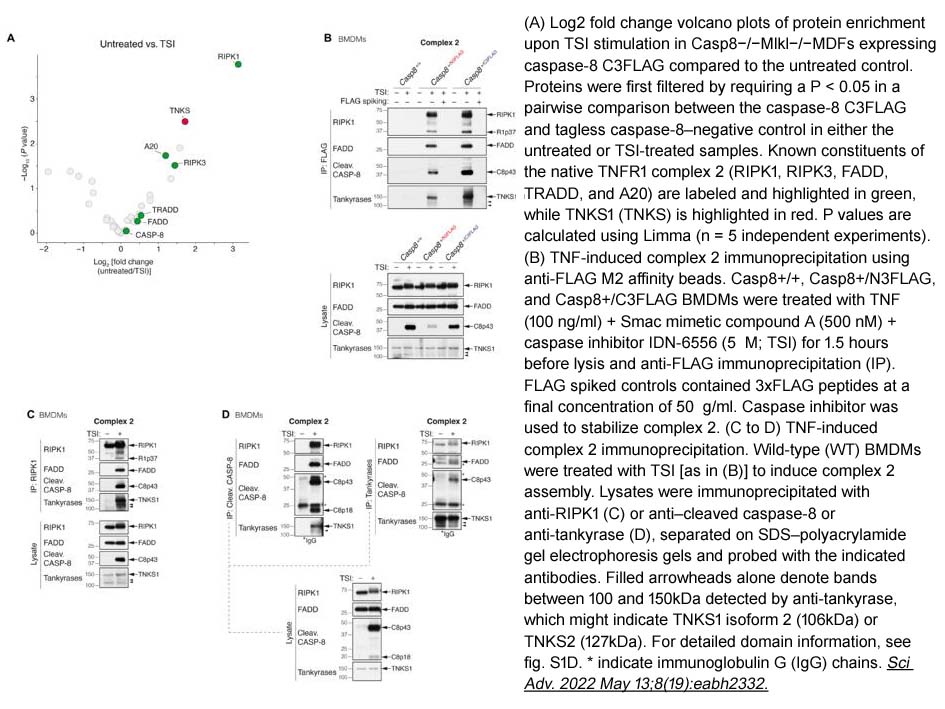
Related Biological Data
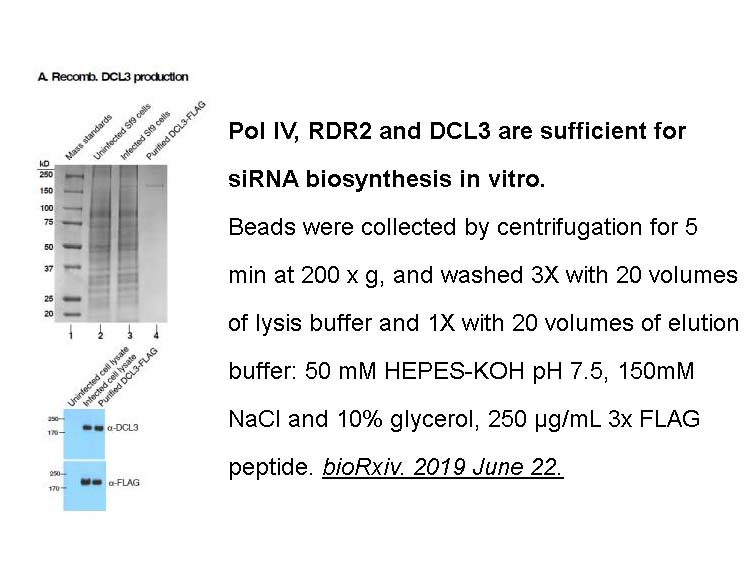
Related Biological Data
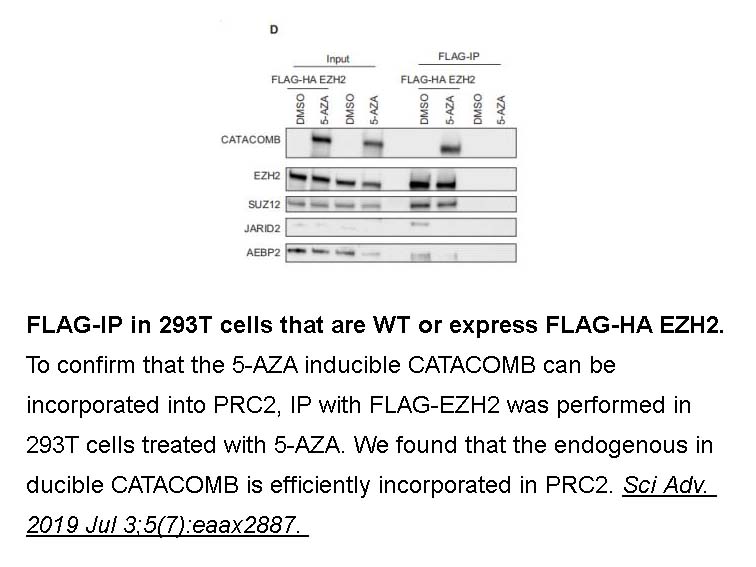
Related Biological Data
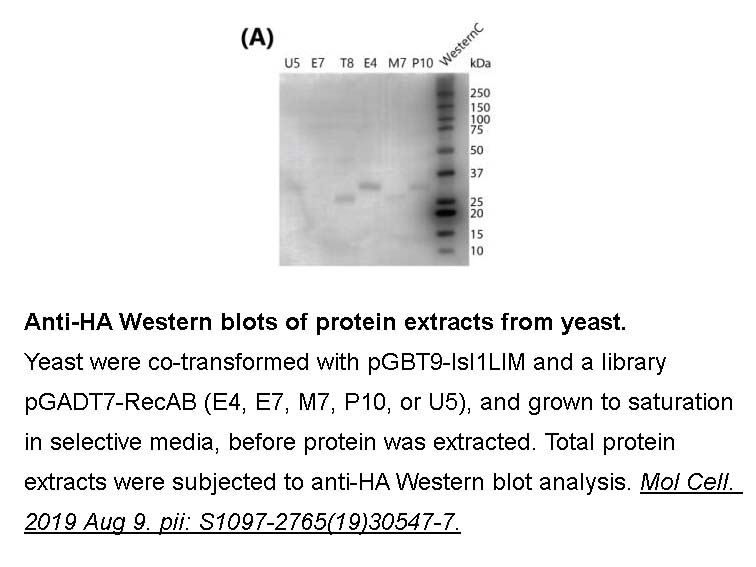
Related Biological Data
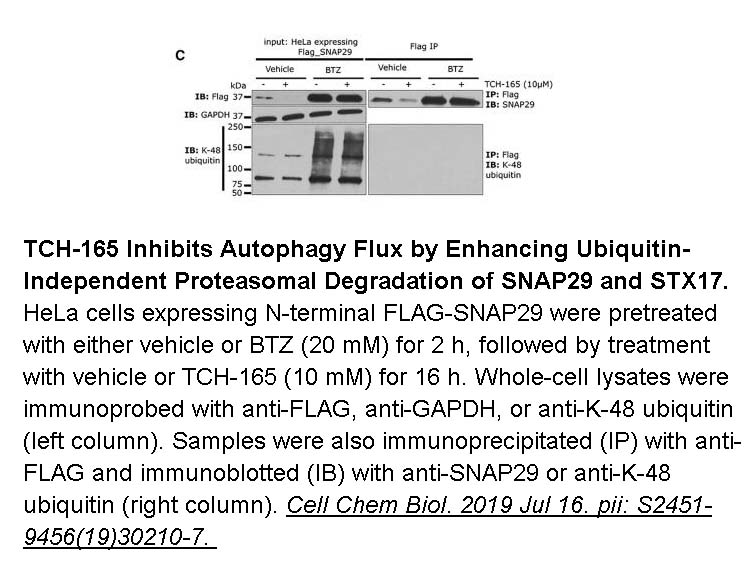
Related Biological Data
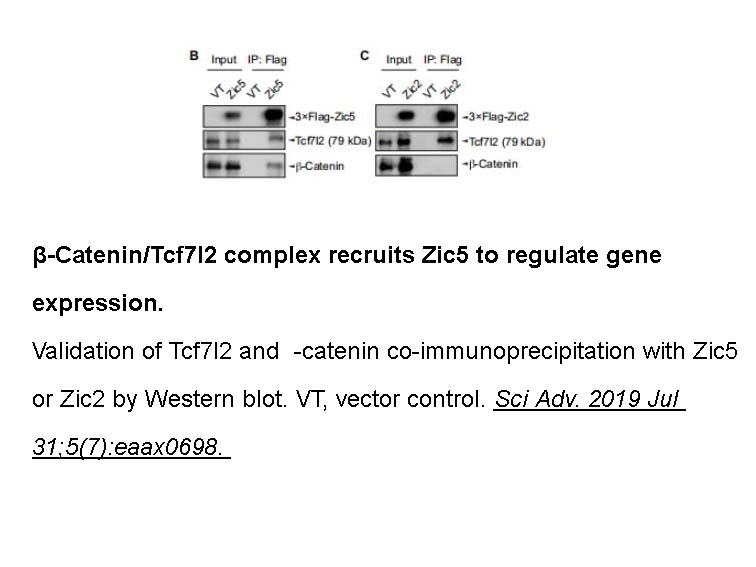
Related Biological Data
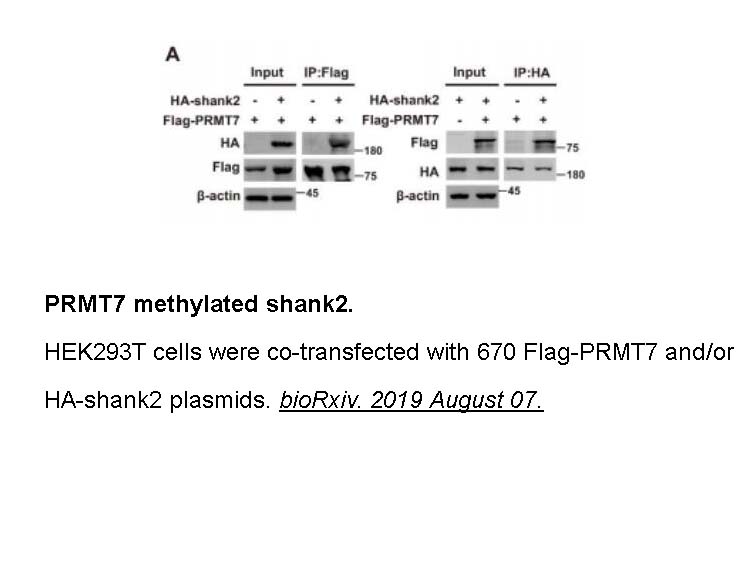
Related Biological Data
